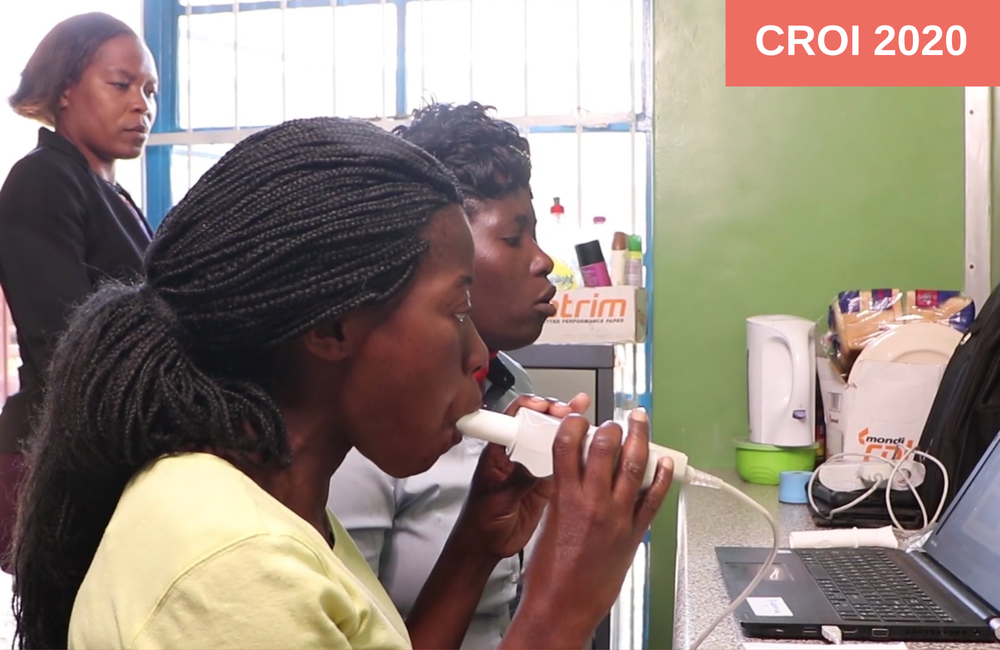
Once-weekly azithromycin reduced morbidity, hospitalisations and acute respiratory exacerbations in children and adolescents living with HIV and chronic lung disease in Malawi and Zimbabwe. The results of the BREATHE trial – the first one ever to address HIV-related chronic lung disease in children and adolescents – were presented yesterday at the Conference on Retroviruses and Opportunistic Infections (CROI 2020) by Dr Rashida Ferrand from the London School of Hygiene and Tropical Medicine (LSHTM).
HIV-related chronic lung disease is common in children and adolescents in sub-Saharan Africa despite antiretroviral therapy (ART). It is associated with significant ill-health, including respiratory tract infections and difficulty exercising. In the ART era, the condition affects small airways, causing obliterative bronchiolitis – a syndrome with dyspnea (shortened breath) and cough – and may be as result of repeated respiratory tract infections and/or chronic immune activation.
Azithromycin is part of the macrolides, a class of antibiotics that possesses both anti-inflammatory and antimicrobial properties. The BREATHE trial investigators hypothesised that it would improve lung function and illnesses through preventing respiratory tract infections and controlling systemic inflammation.
To assess these potential effects of the drug, they recruited a total of 347 children and adolescents living with HIV who had chronic lung disease. At baseline, patients’ characteristics were:
- Aged 6 to 19 years old
- On ART for at least 6 months
- 49% were girls
- 44% had a detectable viral load of at least 1000 copies
- 74% were on first-line therapy
- A median CD4 count of 571/mm3.
In the trial, chronic lung disease was defined as having a Forced Expiratory Volume 1 second, or FEV1 z-score of less than 1, with no reversibility. The FEV1 is obtained with a spirometer, an instrument inserted in your mouth to measure, in z scores, the force of your inhalations and exhalations.
"This is the first trial ever to address HIV-related chronic lung disease in children and adolescents."
Participants were randomised to receive a once-weekly weight-based oral dose of azithromycin or a placebo for 48 weeks. The primary outcome was mean FEV1 z-score at 48 weeks, while the secondary outcomes included mortality, hospitalisations, acute respiratory exacerbations (new or worsening respiratory symptoms, with or without an infection) and weight-for-age (the child’s weight compared to the weight of other children of the same age, expressed in a z-score).
Data from 146 (84%) patients from the azithromycin arm (AZM) and 162 (94%) were available for analysis. There were some differences in baseline characteristics:
- Participants were slightly younger in the AZM arm (14.7 vs 15.8 years).
- There were fewer girls in the AZM arm (46% vs 52%).
- Participants in the AZM arm had been diagnosed with HIV at a younger age (7.2 vs 8.3 years), started ART a bit younger (8.2 vs 8.9 years) and had taken ART for a slightly shorter period (5.9 vs 6.4 years).
- The proportion of patients with a suppressed viral load was slightly higher in the AZM arm (59% vs 54%) and their median CD4 count was also slightly higher (601 vs 550).
About three-quarters of all participants were taking an NNRTI-based ART regimen, and about 90% were on cotrimoxazole prophylaxis, as per the World Health Organization guidelines, to prevent infectious diseases such as malaria and toxoplasmosis.
In terms of the primary outcome, no difference was found between the two arms at 48 weeks. Similarly, when data were stratified by sex, there was no difference across the arms in mean FEV1 z score.
The clinical outcomes read out differently:
- The rate of first acute respiratory exacerbations was 1.92 times higher in the placebo arm than in the AZM arm (hazard ratio 0.52).
- The rate of all acute respiratory exacerbations was 1.96 times higher in the placebo arm (HR 0.51).
- The rate of all hospitalisations was 4.2 times higher in the placebo arm (HR 0.24).
- No difference was found in weight-for-age z scores.
The investigators also observed higher rates in the placebo arm for death, malaria and gastroenteritis, but as there were only nine events in total, Dr Ferrand called for a cautious interpretation of these results.
Good adherence was defined as missing less than three doses during the study. The proportions of participants with good adherence was 67% in the placebo arm and 73% in the AZM arm. A detailed analysis of adherence is under way. Azithromycin was safe and well-tolerated in the trial.
Dr Ferrand highlighted some limitations, including the challenge of adherence in young people over a long period of time.
Nevertheless, she could conclude that after 48 weeks of treatment, while there was no evidence of an effect of azithromycin on FEV1 z-score (the primary outcome), participants in the AZM arm had a lower incidence of acute respiratory exacerbations and hospitalisations. As azithromycin had also proven to be well-tolerated in this population, it should therefore be considered an effective intervention in reducing HIV-related chronic lung disease associated morbidity in children and adolescents.
Laboratory studies are ongoing to determine if the observed impact of azithromycin was mediated through its antibiotic or its anti-inflammatory activity – or both.
Ferrand R et al. Azithromycin for treatment of HIV-related chronic lung disease in African children. Conference on Retroviruses and Opportunistic Infections, abstract 86, March 2020.
